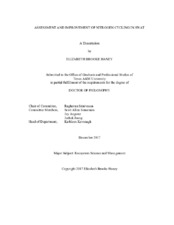| dc.contributor.advisor | Srinivasan, Raghavan | |
| dc.creator | Haney, Elizabeth Brooke | |
| dc.date.accessioned | 2019-01-16T17:26:33Z | |
| dc.date.available | 2019-12-01T06:31:44Z | |
| dc.date.created | 2017-12 | |
| dc.date.issued | 2017-10-17 | |
| dc.date.submitted | December 2017 | |
| dc.identifier.uri | https://hdl.handle.net/1969.1/173084 | |
| dc.description.abstract | The Soil and Water Assessment Tool (SWAT) has been successfully used to predict alterations in streamflow, evapotranspiration and soil water. Previous research suggests that while the hydrologic balance in each watershed is accurately simulated with SWAT, the SWAT model over or under predicts crop yield relative to fertilizer inputs. The SWAT model previously contained three N simulation submodels: (1) basic; (2) N routines derived from the CENTURY model (SWAT-C); and (3) a one-pool C and N model (SWAT-One). We used the measurement of microbial activity coupled with the measurement of water extractable N and C to add a flush of N after rainfall events to create a fourth N cycling option in SWAT (SWAT-flush). SWAT-flush was compared to soil-biological properties and the natural difference vegetative index on a wheat field in Temple, TX, to examine the sensitivity of SWAT-flush to field conditions and found it improved over basic SWAT.
Crop yields from a long-term experiment in Lahoma, OK, managed by Oklahoma State University were compared to wheat yield predicted by the four sub-models. Weather data obtained from the Lahoma research station were used to analyze the impact of precipitation and temperature on simulated and actual yields. Nitrogen use efficiency was analyzed as well as gains in yield relative to fertilizer applications for simulated and actual yields.
Actual crop yields were not significantly different from year to year nor for fertilizer treatments above 22.4 kg N ha-1. Field crop response to fertilizer additions from year to year was highly variable. SWAT-C simulated average yields were closer than other N sub-models to average actual yield. Annually there was a stronger correlation between SWAT-flush and actual yields than the other submodels. None of the N-cycling routines could accurately predict annual variability in yield at any fertilizer rate. We found that SWAT-C and SWAT-flush are the most viable choices for accurately simulating long-term average wheat yields although annual variability in yield prediction should be taken into consideration. Further research is needed to determine the effectiveness of SWAT-C and SWAT-flush in determining average and annual yield in various farming regions and with numerous agronomic crops. | en |
| dc.format.mimetype | application/pdf | |
| dc.language.iso | en | |
| dc.subject | Soil and water assessment tool | en |
| dc.subject | nitrogen cycling | en |
| dc.subject | microbial activity | en |
| dc.subject | SWAT | en |
| dc.subject | CO2 flush | en |
| dc.title | Assessment and Improvement of Nitrogen Cycling in SWAT | en |
| dc.type | Thesis | en |
| thesis.degree.department | Ecosystem Science and Management | en |
| thesis.degree.discipline | Ecosystem Science and Management | en |
| thesis.degree.grantor | Texas A & M University | en |
| thesis.degree.name | Doctor of Philosophy | en |
| thesis.degree.level | Doctoral | en |
| dc.contributor.committeeMember | Senseman, Scott A | |
| dc.contributor.committeeMember | Angerer, Jay | |
| dc.contributor.committeeMember | Jeong, Jaehak | |
| dc.type.material | text | en |
| dc.date.updated | 2019-01-16T17:26:34Z | |
| local.embargo.terms | 2019-12-01 | |
| local.etdauthor.orcid | 0000-0001-6838-5064 | |


